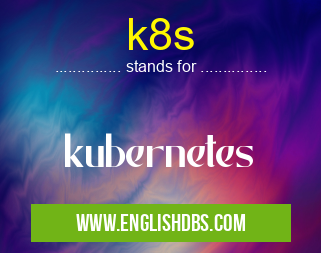What does K8S mean in NETWORKING
K8s is an abbreviation for the open source container-orchestration system Kubernetes. Kubernetes, or K8s for short, was designed to help organizations manage and automate containerized applications across multiple distributed systems. It provides automated deployment, scaling, and management of containerized applications. By working with clusters of computers running images, K8s can provide an infrastructure for deploying, managing and scaling applications at scale. With its ability to make deployments more efficient and cost effective, K8s has become increasingly popular in cloud-native deployments.

k8s meaning in Networking in Computing
k8s mostly used in an acronym Networking in Category Computing that means kubernetes
Shorthand: k8s,
Full Form: kubernetes
For more information of "kubernetes", see the section below.
» Computing » Networking
What Does K8s Mean?
K8s stands for 'Kubernetes'. This open source system enables the automation, management and scalability of containerised applications through a cluster of computers running images. By using Kubernetes (K8s), organizations are able to deploy their application components onto servers quickly and efficiently which results in on-the-fly scalability with fewer resource restrictions than was previously possible without it. As a result, organisations no longer need dedicate resources to managing the infrastructure associated with such deployments or waste time manually configuring every aspect of their environment.
How Can I Use K8s?
Kubernetes can be used in a variety of ways depending on your organizations needs. If you're looking to deploy your application components onto servers quickly and efficiently without sacrificing control or flexibility then K8s may be the right solution for you. You can use it to simplify the process of scaling up or down as needed with minimal manual intervention which saves time and resources in the long run. Additionally, you can use it to easily switch between different environments such as development, staging or production environments quickly and easily without having to rework all your configurations each time you switch environments.
Essential Questions and Answers on kubernetes in "COMPUTING»NETWORKING"
What is Kubernetes?
Kubernetes (commonly referred to as “K8s”) is an open source container orchestration platform for automating deployment, scaling and management of containerized applications. It offers powerful scheduling capabilities, load balancing and storage management. Kubernetes can be used on premise or in the cloud, making it a great tool for managing both legacy and modern workloads.
What type of applications can be managed by Kubernetes?
Kubernetes can manage virtually any application platform, including Docker containers, Windows Server Containers, Java Virtual Machines (JVMs), web servers running on IIS or Apache, NoSQL databases such as CouchDB and Cassandra, Relational Databases such as MySQL and PostgreSQL.
What benefits does Kubernetes provide?
Kubernetes provides many benefits including scalability, faster deployment time, high availability and improved resource utilization. As your application grows in scale and complexity, you will see cost savings due to more efficient use of compute resources. Additionally, Kubernetes helps reduce manual maintenance costs by automating tasks like deployment and scaling of applications.
How secure is Kubernetes?
Security is a top priority for the developers of the open source project that powers Kubernetes. They have implemented various security features such as role-based access control (RBAC) which allows administrators to set specific roles for users; they also provide encryption for data at rest as well as in transit over networks using TLS certificates. Additionally they have added audit logging to monitor system activity for compliance with security policies.
Does using Kubernetes require retraining my DevOps team?
Not necessarily! If your DevOps team already has experience with traditional platforms like Docker or OpenShift then transitioning to Kubernetes should be relatively straightforward. In addition to comprehensive documentation provided by the main open source project there are numerous training programs available online which can help you quickly get up to speed with all aspects of managing clusters in production environments.
What do I need to run a cluster in Production with Kubernetes? A: You will need some form of Infrastructure-as-a-Service (IaaS) such as Amazon Web Services (AWS), Microsoft Azure or Google Cloud Platform (GCP). You will also need a supported operating system such as Ubuntu 1605+, RedHat 7+ or CentOS 7+. Finally you must ensure you have enough physical resources available such as CPU cores/RAM/disk space etc to satisfy all your needs before deploying the cluster into production.[END] Q: Is it possible to migrate existing applications into a kubernetes cluster? A: Yes absolutely! The process starts by replicating your existing environment into an appropriate IaaS provider then configuring the kubernetes cluster accordingly before deploying your application containers/services onto it. This may involve porting existing services/applications from other platforms depending on their original architecture but generally speaking this is quite straightforward so long as suitable images exist already.[END] Q: Can I scale my kubernete Cluster automatically?
You will need some form of Infrastructure-as-a-Service (IaaS) such as Amazon Web Services (AWS), Microsoft Azure or Google Cloud Platform (GCP). You will also need a supported operating system such as Ubuntu 1605+, RedHat 7+ or CentOS 7+. Finally you must ensure you have enough physical resources available such as CPU cores/RAM/disk space etc to satisfy all your needs before deploying the cluster into production.
Final Words:
In conclusion, K8s is an abbreviation that stands for Kubernetes. This open source system has revolutionised the way organisations deploy their applications by providing them with an efficient platform that allows for automated deployment, scaling and management of containerised applications across multiple clusters of computers running images. With its ability to provide on-the-fly scalability at minimal cost while saving time spent configuring environments upon switching between them; it's easy to see why K8s has become so popular amongst cloud native deployments today.
